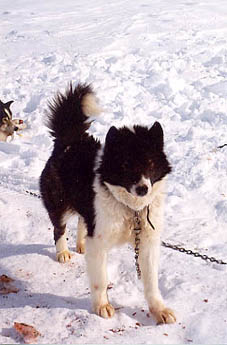Table of Contents
*
Fan Mail
*
Breaking Away: The Liberation of Ove Nygaard
*
What is the ISDI and the ISD?
*
A Holiday Miracle
*
Of Sheep and Sled Dogs
*
News Briefs
*
Qamutiit and How They're Loaded
*
The Truth Behind the Madrid Protocol
*
Media Review: Globe Trekker - Iceland and Greenland
*
Product Review: Ryobi TrimmerPlus®
*
Tip for the Trail: Bitches in Season
*
IMHO: Super Cars and Inuit Dogs
Navigating This
Site
Index of articles by subject
Index
of back issues by volume number
Search The
Fan Hitch
Articles
to download and print
Ordering
Ken MacRury's Thesis
Our
comprehensive list of resources
Talk
to The
Fan Hitch
The Fan
Hitch home page
ISDI
home page
Editor: Sue Hamilton
Webmaster: Mark Hamilton
Contents of The Fan Hitch Website and its publications are protected by international copyright laws. No photo, drawing or text may be reproduced in any form without written consent. Webmasters please note: written consent is necessary before linking this site to yours! Please forward requests to Sue Hamilton, 55 Town Line Rd., Harwinton, Connecticut 06791, USA or mail@thefanhitch.org

Reebok, a young
female
Hamilton
photo
Super Cars and Inuit Dogs
by Mark Hamilton
It's been quite some time since I've done an automotively slanted column, and this time I found the temptation too great to resist. For those of you who are not "gear-heads", sorry, but this really is the best analogy I can come up with for the topic.
You see, people keep asking me why I always say that Inuit Sled Dogs are not pets. I most often get this question in public settings, where our dogs are behaving as responsive, interactive, well socialized canines. I think it's easy for many people, after seeing a happy, social animal, to assume that it would make a great pet.
Back in the 1960s the U.S. automakers came up with a group of automobiles that were ultimately labeled "muscle cars". The formula was pretty simple: take a mid-sized, lighter weight car from your product line and stuff the largest engine you possibly could into it. As more and more manufacturers entered the market place, competition for customers demanded the manufacturers offer more features, and upgraded brake and suspension systems appeared on the option list. Compared to the other cars of the time, "muscle cars" were brutally fast in a straight line, but not particularly competent on any road more demanding than a super highway. Insurance rates and emission regulations killed off the "muscle cars".
The next round of performance cars were identified as "super cars". Most of these vehicles were offered by European manufacturers, and they were little more than slightly detuned, race cars with the addition of such civilized features as fully upholstered interiors and maybe a nice radio. From the first, "super cars" made the older "muscle cars" look slow, and the sophistication of their suspension and braking systems compared to the old "muscle cars" was as a Monet masterpiece compared to a kindergartner's finger painting. Construction materials and techniques were often lifted wholesale from the racing cars they were based on.
The "super cars" were so precise in their response, and so responsive to the driver's input, that it was easy to feel comfortable driving them fast. They also carried over the handling and braking characteristics of their racing forebearers, and more than one driver was unprepared for the car's behavior once they found themselves exploring the upper range of its performance envelope. The abruptness with which the formerly easily driven, well-mannered vehicle surpassed the driver's ability to control it sometimes became the ultimate and very last surprise of that driver's life.
Well, we're finally back to those responsive, interactive, well socialized Inuit Sled Dogs, and the people who see them and think they would make great pets. Just like those "super cars", the ISD can lull the unknowledgeable and the novice into a false sense of control. Their "exaggerated response to every stimulus", that Bill Carpenter refers to when characterizing the breed, can fool the unsuspecting into mistakenly believing that an animal merely focused on being social with people, at that moment, is in fact a cuddly house pet. I believe the average dog admirer has difficulty differentiating between a dog that is being social and another that actually is a pet. While an Inuit Dog is capable of being companionable, and even a companion for a few people whose lifestyle, activities and understanding of canine behavior are compatible with the ISD's basic makeup, they fall far short of having the qualities and characteristics that are expected in a pet. And just like those "super cars", they surely can get out of control on you if you don't know what you are doing.